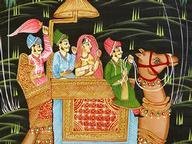Quiz Answer Key and Fun Facts
1. The aughisky of Ireland were similar to the each uisge of Highland folklore. Both were water creatures that could take the form of land animals, but an aughisky could be caught and tamed by humans. What form did they take on land?
2. Which of these solitary little men is thought to be quite industrious?
3. Which benevolent hobgoblins (or goblins, or elves, depending on the source), called bwca in Wales and bodach in the Highlands, are said to be invisible to disbelieving adults?
4. The redcap was one of the wickedest of the evil fairies, and was said to live in a region prone to fighting and evil deeds. Where was it?
5. Selkies were said to be metamorphs who could change from seal to human form. In what way could selkies be taken for wives by human men?
6. Who is the cannibal hag said to be the reason Leicestershire cottages have small windows, so that she could only get an arm inside?
7. Called the bean sidhe in Ireland and the bean nighe in Scotland, this spirit fortold death. What is it?
8. The most horrid of the Scottish fairies, this sea-creature of folklore was part humanoid and part horse. It had black veins, which were clearly visible for it had no skin. It had but a single weakness, which was an aversion to running water. What was it?
9. What mythic Irish poet, soldier, and singer was the son of Finn MacCool and the fairy woman Sadbh, was stolen away to Tir Nan Og by the fairy woman Naimh of the Golden Hair, and survived to see the advent of Christianity in Ireland?
10. The duergar from northern English folktales is a sort of malicious _____.
11. What Irish creature of folklore liked to appear as a pony and then take riders through marsh and thorns and then throw them into a ditch or pond?
12. Which attribute did Puck, the Hedley Kow, and the brag of Picktree in Northumberland have in common?
13. The rulers of the English fairies are Queen Titania and her consort Prince Oberon. Their court was said to be in the vicinity of which of the following?
14. Stories of Gwrach y Rhibyn and the Ellyllon are from what part of the British Isles?
15. What's the pronunciation of the word "sidhe"?
Source: Author
ironikinit
This quiz was reviewed by FunTrivia editor
fringe before going online.
Any errors found in FunTrivia content are routinely corrected through our feedback system.


